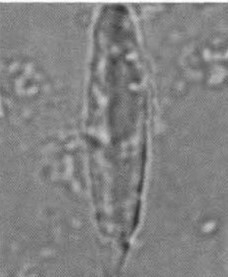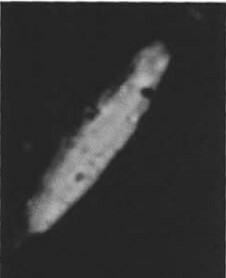Pennalithus rioi
Set number: 255
-
1
-
2
-
3
-
4
-
5
-
6
-
7
-
8
-
9
-
10
-
11
-
12
-
13
-
14
-
15
-
16
-
17
-
18
-
19
-
20
-
21
-
22
-
23
-
24
10µm
in mobile mount
Set number: 256
-
1
-
2
-
3
-
4
-
5
-
6
-
7
-
8
-
9
-
10
-
11
-
12
-
13
-
14
-
15
-
16
10µm
in mobile
Triquetrorhabdulus rioensis Olafsson, 1989
1998 Triquetrorhabdulus rioi Olafsson – Young in Bown, Pl. 9, Fig. 18, 19 non-Pl. 9, Fig. 17, 20.
Narrower species of Pennalithus exhibit two blades of slightly unequal width and a median ridge, often straight. This species naturally settles in the plan or side views.
Optical Properties: In the side view, Pennalithus rioi displays high birefringence (Plate 18, Figs. 9-11, 13-15 in Varol, 2025). The blade shows first-order yellow interference colours, while the ridge exhibits second-order red and blue colours. Pennalithus rioi produces parallel extinction, with an extinction angle of 0° (Plate 18, Figs. 10, 14 in Varol, 2025). It exhibits length-slow (+) elongation in this orientation. In the plan view, when the ridge faces observers, Pennalithus rioi experiences constant extinction; the optic axis is perpendicular relative to the microscope stage in this orientation (Plate 18, Figs. 17-19, 21-23 in Varol, 2025).
Olafsson, G. 1989. Quantitative calcareous nannofossil biostratigraphy of upper Oligocene to middle Miocene sediment from ODP Hole 667A and Middle Miocene sediment from DSDP Site 574. Proceedings of the Ocean Drilling Program, Scientific Results 108: 9-22.
Varol, O. 2025a. A practical guide to optical studies of calcareous nannofossils. Grzybowski Foundation Special Publication. 29: 1-222
Young, J. R. 1998. Neogene. In: Bown, P. R. (Ed.) Calcareous Nannofossil Biostratigraphy. British Micropalaeontological Society Publication Series . 225-265.

